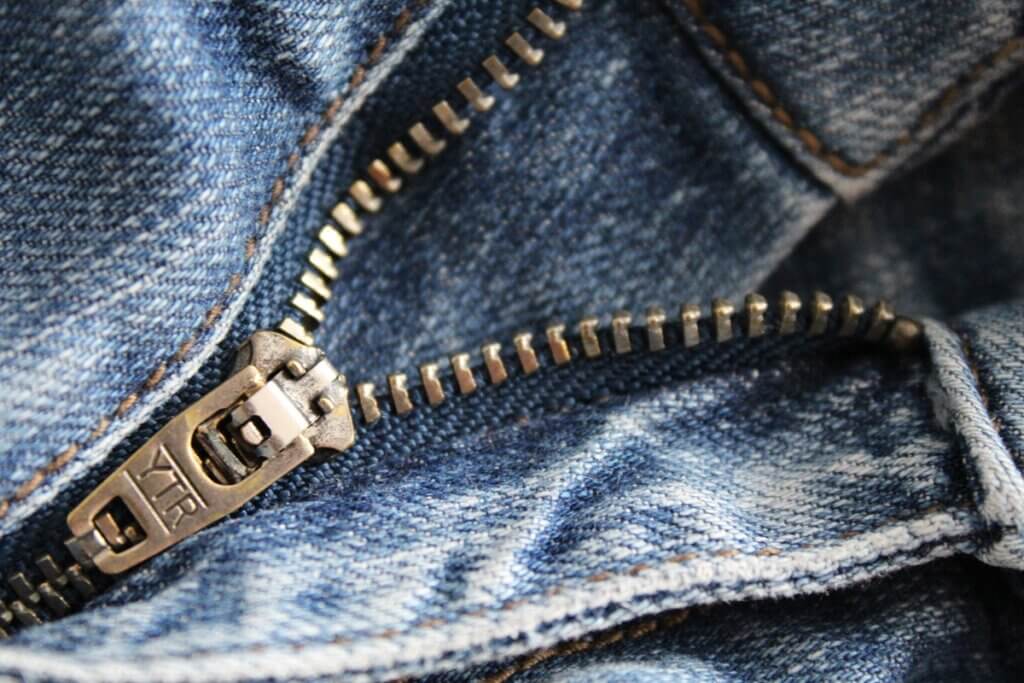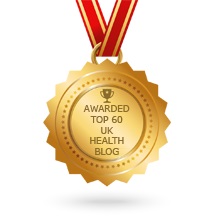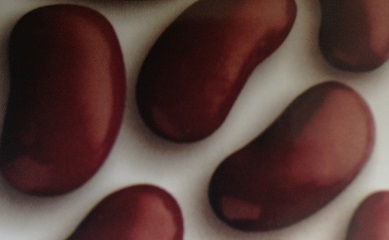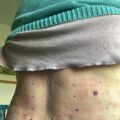Mysterious rashes and itchy waist bands could be caused by the very clothes on your back. If you’re desperately trying to pinpoint what is causing a mysterious rash there are a few quick win things to check.

- Have you changed washing powder recently? – Many people are allergic to biological washing powder so stick to non-biological and you should be fine. Avoid fabric softeners too and things that add fragrance – if you’re clothes are being washed they don’t need these extra things. Keep it simple. Better for you skin and much better for the environment too.
- Are the clothes that make you itch new? – You might be shocked to hear that new clothes often have formaldehyde coated on them to prevent them getting creased. Yes, you heard me. Formaldehyde! The poison! ‘Why is this even allowed?’ I hear you cry… I have no idea, but it seems that manufacturers are somehow claiming that it’s such small quantities they’re using and that it can’t possibly harm people. Oh yeah? It makes me itch like crazy. I’m now sadly never surprised at the crazy things that are allowed in our foods and industry practises. To get around this nasty little problem simply wash new clothes before wearing, though there are people who are so sensitive that they will only wear second hand clothes which will have no trace of formaldehyde left at all. I really worry about the effect this might have on small babies and children.
- Did you buy some clothes make from milk? – Yes, again, you heard me correctly. Anke Domaske, a 28-year-old biologist and fashion designer from Germany is making clothes from fibres that are extracted from substandard milk that is usually thrown away. She uses these fibres to create a milk yarn fabric, manufactured without the use of any pesticides or chemicals. She then uses the silky smooth fabric to make her clothing designs. On the face of it this sounds like a great idea. Anke says: “Milk is underrated because people only view it as a food-stuff. But you can make a lot more from it – milk is a wonderful, natural raw material. The special thing about milk is that is has a lovely silky feel. The fabric falls wonderfully, and it’s cheaper than silk.”
Cheaper than silk it may be, environmentally friendly it may be, using a waste product of milk that would otherwise be thrown away, but these dresses are not for the milk allergic. Can you imagine? If you’re interested you can find out more about Anke’s designs and how she makes the fabric by watching the Clothes made from sour milk video. - Uniqlo Heattech thermal clothes contain milk – Japanese company Uniqlo mix rayon and milk protein to create a unique system which traps moisture enabling the garment to retain heat.
Read more here: http://www.esquire.com/style/uniqlo-heat-tech-series-1208#ixzz1lK71fex0 and be careful which thermals you buy. I think these thermals are only available in Japan and America but watch out! I’m not sure if this is stated on the label. - Latex allergy from elastic in clothes – Imagine if you were allergic even to your knicker elastic? If you have a serious latex allergy many clothes could cause you a problem, and I’m not just talking about your rubber fetish outfits.
- Nickel allergy a problem with clothes – Studs in jeans, zips and buckles can cause problems for those with serious nickel allergies. I find that if I keep small change in the pocket of trousers or jeans it will eventually work its way through and cause me a slight rash. If you have a nickel allergy this just might be what’s causing you the problems
- A woolly problem – If you have sensitive skin it’s often a good idea to avoid wearing wool next to your skin too, as it can cause an itchy rash for some people. You may find however that pure merino wool will be fine. I have some merino wool thermals and a jumper and they don’t itch at all and amazingly warm.
- Black dye in clothes can also cause allergies – Apparently black dye in clothes contains more PPD than any other dye colour. If you’re allergic to PPD stick to neutral colours and plain cotton clothing.
- Phthalates found in plastic logos and shoes – Linked with hormone disruption such as reducing male sperm count, phthalates are found in some clothes with plastic logos and also, many new shoes and clothes have a strong, plasticky smell which can indicate they are full of phthalates.
- Perfluorinated chemicals used to make some breathable fabrics are also dangerous — they accumulate in the body and are known to be carcinogenic.
- Fabric treated with brominated flame retardant – This chemical has been known to be used to treat childrens sleepwear but it’s highly toxic. Far safer to take proper precautions and fit a smoke alarm than have your child wear anything treated with this.
Using casein from milk to make clothes
Watch this video to find out more about how clothes are made from milk! it’s supposed to be better for people sensitive skin as it’s antimicrobial and anti bacterial! But is this safe for those with a milk allergy?
You can find out more about two ladies who are so allergic to these toxic dyes and chemicals added to our clothes. Read “Toxic dyes, lethal logos, cotton drenched in formaldehyde… How your clothes could poison you.”
Unfortunately it seems clothing manufacturers are under no legal obligation to disclose the chemicals used to treat and process garments.
I’ll be looking into chemicals in our environment in a later blog. You might be surprised to know that formaldehyde is commonly found in mattresses, bedding, carpeting, MDF, furniture and in most of the clothes that we buy – how do all these separate exposures to this colourless gas affect our health in the long run? Formaldehyde is a known carcinogen so in my view it should be banned from use in all the above listed products, all sold for use in our homes. Our homes where we think we’re safe, cosy and warm in an insulated box which doesn’t allow these gasses to get out. A toxic soup!
Rashes can be caused by many things as well as foods, stress, viruses etc. and it can be hard to pinpoint exactly where they’re originating from. Ever found new clothes irritating and wondered why? Shocked that formaldehyde is permitted for this use? I’d love to hear what you think about these crazy allergy clothes problems.












Formaldehyde is only one of the aldehydes that are used in the world of chemistry. And it’s the simplest. If you’re not an organic chemist or don’t have a very good understanding of organic chemistry, this will be quite confusing, but a read through the Wikipedia listings of the following topics is a real eye opener… Aldehyde, Aldose, Oligomer, Carbohydrate … these are but a mere sprinkling of the multitude of links you can investigate through these pages.
The take-away from knowing this information is simple. Synthetic chemicals provide shortcuts. Many of these shortcuts are quite beneficial in out-of-the-human-body-activities; manufacture, engineering, design, etc.. But, when they are introduced into the organic system of the human body, their shortcut design causes them to short-circuit many vital functions within the body; most occur at the micro-molecular level. The result? Over the long-term the body builds upon shortcut technology, only to find vital structures either vastly weakened or non-existent. Not a happy outcome… that has had very little thought to these outcome potentials.
YOSAKIME
Hi YOSAKIME, I thought I’d replied to this but can’t see it anywhere. I never knew about all the other alderhydes etc. I agree and I can see why companies use chemicals but they shouldn’t be able to when they don’t understand the short term, let alone the long term effects, and NOONE considers the effect of all the chemicals added up together – a toxic soup in a lot of cases. Our bodies aren’t made to cope with that. Could the rise in Cancer and similar illnesses be attributable to manmade created problems due to all these articifial things our poor bodies strive to process? We could have a really good rant about this some time. Thanks for the comment. I have learnt a lot. How do you know so much? Have you just done lots of research? or your backgroun science and chemicals?
Hi Ruth
I was interested to read about clothes and itchy skin.
By pure chance my girlfriend washed our clothes without any detergent at all. And d’you know what, they came out just as clean and fresh as when she uses Persil and no itchy skin. OK, so the clothes weren’t particularly dirty, once-worn t-shirts and such, but it struck me that the action of a modern washing machine alone will agitate the water molecules sufficiently to shift light soiling. We use far more chemical powders and liquids, optical brighteners and bleaches than we need or are are good for us/the planet. So
I’ve now invested in a wash ball from AllergyBestBuys.com. No more expensive washing powder and hopefully no more itchy skin.
That’s a very good idea. Never tried it. I always use nonbio. You can also get those washing balls, have you tried them? Chemical and detergent free. You can buy them here: http://www.ecozone.com/
Dear Ruth:
I was recently diagnosed with a severe allergy to formaldehyde and all of its releasers. This diagnosis finally came after over 10 years of terrible dermatitus. I am completely overwhelmed and confused as to what clothing is safe to wear and what is not.
My understanding is that items that are 100% cotton (excluding wrinkle resistant), polyester, silk etc (excluding rayon) are safe to wear after washing numerous times in hot water. But that blends are not okay no matter how many times washed. Also that retailers that follow Japanese coating guidelines (75 ppm of resin as opposed to the 300ppm that many manufacturers use) are okay as well.
Please advise if you have any information confirming any of the above.
Many thanks 🙂
Krista
Hi Krista, I have a mild allergy and usually washing once of twice is enough for me, but I’m not ure about which types of material make a difference but I wouldn’t be at all surprised. I’ll try to find out for you. However I did get given a lovely performance wear wicking top for cycling and even after three washes it still smells as strong as ever. I’m not sure if this one will ever lose that smell which will be shame. I also didn’t know about Japanese fabrics. Organic and cotton should be the safest bet but it’s often hard to find in the fashion you prefer. However dermatitis is not fun fashion statement either is it so I guess at least you know now what to avoid. One thing I find that helps is to go to charity shops – you can ofter find some really nice stuff in there which has already been washed by someone else. I always give things a wash when I buy them from charity shops just in case I’m allergic to their washing powder but it’s a safe way of almost guaranteeing it’s free from formaldahyed. However you can often find nearly new and hardly worn stuff so the many washes rule would still apply. It drives me mad. Why do they do it? Well I know why but I just wish they didn’t! Also, which country do you live in? Google for local suppliers. I’ve heard of Cottonique but not found it yet anywhere. This brand is organic and formaldhyde free. Does anyone else know of anywhere? If you google organic clothing there are loads. You could try Bamboo clothing which is really soft and often organic. Quiz the retailers and find out. I might have to do a blog about this. It’s not easy to find out is it? Good luck. Keep washing and hanging stuff out on the line (when it’s not winter) really helps too. Shame it always ends up being more expensive clothing too but that’s life hey.
Thank you for your post. Twice in the last week I’ve tried on a new item of clothing only to have a pretty severe allergic reaction – itchy skin, trouble breathing, some swelling around the mouth, etc. I know it’s something in the clothing, but had no idea what it was. Thanks to your post, I’d guess formaldehyde is the culprit. Can’t say I’m happy to learn this, but on the other hand, it will help me with a course of action to avoid any further reactions.
Charity shops are great, pick an affluent area and you can find some grt stuff
Thanks for the post! I have an awful time buying clothes. I’ve bought so many clothes I couldn’t wear even after multiple washes. It also took forever for me to find the right detergent, but I did! And organic clothes give me just as hard a time as regular. It frustrates me terribly that they don’t disclose info about the ingredients because that means I have few to no ways of knowing whether I will be allergic. I’m gravitating towards second-hand as well, but it’s still not a sure thing.
I should also also mention that my symptoms aren’t only skin-related but also respiratory, headaches, etc. What do they put in our clothes, I wonder!
Hi Chantale, I don’t know but I don’t like it. I have a lovely black cycling top that I have washed about five times. My husband gave me it and every time I put it on it just makes me feel strange. Not a skin reaction either I just know I don’t like it. Kind of a mild headache but I can also smell the strong strong smell of something impregnated in it. Why? Why? What are they doing? these clothes manufacturers. I haven’t found a brand which is totally safe but generally wash a few times and I’m OK. It’s better in the summer when they can also hang on the line outside to get aired. The lengths we go do hey?
I just had the same thing (mild headache and breathing thickness) when wearing a a new black denim vest from Calvin Klein. I know I can easily return it but I like it! Do you think its worth trying to wash it first?
It’s strange because the last time I had this reaction was when I bought my Kindle(The cover also uses black dye)
Hmmm… I’m not sure on the science of this. ie. how many washes would be needed. I know people who will only buy dark colours from charity shops, but even then, I’ve found clothes with tags still on and never washed. If you really love them, I would suggest a few more washes and a lot of airing. I have a black cycling top which stank of something which made me wheeze for at least ten washes! My husband bought it for me so I didn’t want to take it back, but I almost gave up hope. The top was completely imprgegnated and it’s either the dye or for me, I think it’s what they put on clothes, the formaldehyde which stops stuff getting mildew and mould in transit and prevents the need to iron. I now sniff clothes before buying them as some are better than others.
Hi Ruth,
I have also become an unfortunate victim of all of this via a pair of black denim jeans I ordered from a well known catalogue company. I have had jeans from them before, same brand just a different size with no ill effects but this pair felt ‘wrong’ from the moment I put them on and by the time I took them off my legs, hips and stomach were covered in an angry raised rash. We contacted the company and they refunded us which seemed fine at the time however even though the rash on my legs disappeared it triggered a complete over sensitisation of my immune system which has seen me become allergic to foods, things I use, my job, painkillers in fact it changes its mind almost every week as to what I’m allergic to. The worst affected has become my mouth..not inside but my lips and the skin around my mouth. I have developed urticaria and that area is the worse affected. My mouth swells, blisters, becomes incredibly sensitive, the skin weeps and crusts… I spend at least a couple of days each week in agony. The only relief I get is when I get put on a course of oral steroids which in themselves cause problems. My life has been complete hell now for about a year and I’m utterly powerless to do anything about it thanks to a pair of jeans!
Hi Red, can I call you Red? I have heard that a crisis moment for the body can set it into an immune system overdrive you describe. Do you know a good nutrtionist of dietician? Maybe ask your doctor to refer you. If you keep a really detailed food diary of exactly what you eat and the symptoms they should be able to help you piece together which foods are causing the problems for you. Is the reaction on your lips a cold sore? Or something else? These can be triggered when the body is under stress and also by different triggers like food. Please do try to find a local specialist who can help you get your immune system back on track and find a balanced diet that doesn’t leave you in so much pain. I know how you feel, I’ve been there. It is a horrible place to be. Good luck with finding some relief.
Hi Ruth,
Although some foods do affect and aggravate it they aren’t the main triggers for bad outbreaks, it seems to be mainly airborne particles such as strong smelling plastics, essential oils, citric acid dust (part and parcel of my current job, I know I need to change employment but have also reacted to things in the atmosphere in other places I’ve tried and I cannot afford not to work), etc that cause the bulk of the problem. So far I have eliminated any foods that I can identify as causing issues (although there are a couple I’m not sure about) but as I already have a very healthy diet and make majority of my meals myself it in a way make things more frustrating as I probably don’t have as much I can eliminate. Some blood tests are being currently done to check on those I think are causing issues. I am also currently looking in to some minor alterations diet wise to try and boost my system.
No the reaction on my lips isn’t down to cold sores as it’s very specific in the way it behaves. Most reactions are from airborne strong smelling or highly irritating particles, the only exception to that so far was an apparent ‘allergy’ to sunlight that plagued me through the summer, helped the rest of my skin but made my mouth worse. The other parts of my body that have bad reactions are all the exposed areas such as hands and face, and the right hand gets the worst of it.
I’m back on oral steroids again to bring down the latest outbreak (caused by a trial run for a potential new job which I had to turn down) and have now been referred to a dermatologist although I will need to wait for an appointment to come through. Although it is very stressful I use meditation to keep that in check so I guess it could be a lot worse. I have also found drinking nettle tea is helping a great deal between bad breakouts. Somehow I need to flip my already strong but now over-active immune system back on to the correct setting.
Thanks again Ruth for your advice and for having this page so that people who are affected feel less alone. I wish you and all others luck with it and good health.
I have recently noticed I am having reactions to the elastic in my clothes. Looking back, it is clear I have been allergic for at least 15 years. I do well with cotton but am having a hard time finding any undergarmets without spandex or elastic? Any suggestions on this, or good natural (organic) clothing brands?
Hi Courtney. It is hard to find and if you do find any it’s pricey. Try Allergy Best Buys, White People, Komodo.co.uk or greenfibres.com
Uniqlo Heattech shirts contain biocides, which are “durable against daily washing” because they are supposed to prevent odour. I bought two Uniqlo Heattech shirts in the UK, a Scoop Neck Long Sleeve T-Shirt and an extra warm Crew Neck Long Sleeve T-Shirt. These have been treated with Zinc Pyrithione and 3-trimethoxysilyl Propyldimethyloctadecyle. I WAS SHOCKED, especially as this fact is concealed on the homepage as “odor-minimizing fabric”. Interestingly, on the packaging itself there is a clear warning “This product contains the biocide XY”. I would have never bought this product if I had known this in the beginning.
Did you wear them Ann before spotting this treatment? I think it’s disgusting and dangerous. Who knows what the long term effect of these chemicals will be. It’s as if they are experimenting on us customers. I would take them back if you can.
I’ve always avoided flame retardant clothes for my kids. But I took my 5 year old to pick something out for himself recently and the only thing he wanted was a flame retardant robe. I almost didn’t buy it but I told him he could puck something out…so we got it. This week we were snowed in and my son wore his robe overnight, most of next day then again that night. When I tucked him in, I noticed red marks on his face and opened the robe and he had broken out in hives! Benadryl and shower and a half hour later were backing off. We had been stuck at home a few days so no new exposure. No new cleaners, detergents, no new foods. Literally the only change in his environment was the amount of time he had spent in that robe. Never again!
I really don’t understand why clothes need flame retardants on them? Obviously we all know fire is dangerous and don’t want to burn, but if you ever got caught in a fire, would flame retardant clothes be much protection? I am sorry your son had such a nasty reaction but what will you do with the robe now? Take back to the shop I think – did you take photos of the reaction? Manufacturers will continue to make products like this unless we all shout that we don’t want it and it in fact makes us sick. Thanks for sharing and hope your son is all healed from the hives now.
Pictures and letting store/ manufacturer know is a good idea. I’m thinking about having him put it on with me with him with the Benadryl handy and do maybe a controlled exposure. My fear is since he already reacted, the next reaction could be worse. Even though he had hives, there was no respitory reaction- no runny nose, breathing, nothing and he wasn’t even scratching after the medicine and shower. It would let us know for sure. I’ve never understood flame retardant sleeping clothes Its a toxin so I avoided them. Most fire experts would tell you the smoke will get you before the fire does. Nowadays people don’t live next to their fireplace as much. I think the risk of a toxin next to my kids’ skin all night long is greater than a fire that, God willing, never comes.
It would confirm your suspicions. As it could possible have been a new reaction to something else, they do crop up out of the blue sometimes. I got a latex allergy one day blowing up balloons with no previous problems before that. Does he react to dust? However since the reaction was all over him where the robe was in contact with his skin I would highly suspect the robe. If you do the experiment, take pictures and have a very special treat afterwards. Being a child lab test patient is not fun. Would love to hear how you get on, but make sure it’s a night when you have no plans the next day in case he’s suffering. I was going to say have fun but I’m not sure either of you will!!! Good luck.
Look for clothes that are Oeko-Tex 100 certified. This means that they do not contain a whole heap of stuff that can harm you.
https://www.oeko-tex.com/
Thanks so much for thiis comment. I missed it first time around but the website looks great! Thanks for sharing I will check it out.
It would be great if you could write about zinc pyrithione found in clothes and any dangers if any. Thanks!
Too bad the response to this blog topic has died down. It was as really good one.
It response to more info about the zink pyrithione ,its used as an antifungal and antibacterial.
They add it to certain clothing’s to help keep odor from building up in the clothing.
Sweat. Sweat has all sorts of bacteria in it. It doesn’t take long for fungus to start growing.
That wear the zink comes into play.
It may cause skin problems for some, but oddly enough it is often used to treat
Seborrhoeic dermatitis! Go figure. Lol
At any rate there just isn’t e enough info known about risk factors with these chemicals when used in clothing.
Here is just one of my pet peeves.
The new front loading washers just don’t use enough water. The people that do own them have not read the instructions to use less soap. Way less soap.
The soap and fabric softeners are left IN THE CLOTHING.
IT DOES NOT GET RISNED OUT ENOUGH!
People dress their little children in these c!othings, the kids we’re them, but as their body heats up the left over chemicals start to be released from the clothing.
This clothing it ALL- RIGHT UNDER THEIR LITTLE MOUTHS AND NOSES.
THEN IT IS BREATHED IN WITH EVERY BREATH.
When you breath through your nose the chemicals pass through the brain barrier,
INTO the BRAIN!!!!!!
Then at mite time these sweet little kids climb Into a bed of freshly laundered sheets and bedding. O my to breath it in all night.
We wonder why they can’t sit still or concentrate.
People quit using these dangerous lay laundry products.
Its NOT THE SMELL they are sea ringvringv to,
ITS THE CHEMICALS THAT MAKE UP THE SMELL.
THERE IS A DIFFERNCE!
About 4 months ago i had my car worked on.
When tney were done they tok it off the rack and drove it to the paking lot of the business.
He was in it for less than 2 minutez.
I got back in my car to drive home.
I could immediatly smell the laundry soap and fabric softner in my car.
Got home got out of the car, and smelled the car seat.
Just about knocked me out.
I was angry! Idjust bought the car less than a month earlier.
I go into my house sit on the couch and can. Still smell It.
It was imbedded in my jeans.
I waned them over and over.
I had to throw them out. Every time I wore the. I could not only smell it, I could taste it in my mouth.
Its been 4 months now. My car was so stinky the next day when I opened the door. It made me dizzy to drive it.
Thankfully it was summer. So I could leave the windows open.
But that didn’t help.
Finally I covered the seat in black garbage bags. Bought a new seat cover and out that on.
Tho it helped some, its STILL THERE.
I’m not having physical reactions so much anymore, but the perfume Stink still lingers.
This is dangerous stuff.
For me, I’ve become so reactive to these chemicals, I can’t even ride in a car with other people. Just being in line with people , outdoors I can smell all the laundry products
OOZING out of their clothing.
When I go for walks I. The evening, I can smell e eryone doing their laundry.
Sometimes its so strong it makes me feel drunk!!
OK. I’m done. I could on. And on……..AND OOON. But I won’t.
Oh then there are the glade plug-ins , the new scented oils that are called natural essential oils.
Unless YOU are making them yourself, don’t believe they are natural.
Most of the time petroleum products are used to extract the oils.
Ok. Really I’m done. Even tho I have so much more I want to say. Lol.
Somehow we have to be heard.
Thanks for a place to ramble….. On and on and on.
Thanks for this comment, I hear your pain in every word. We need to get back to our normal odours. If you wash regularly and clean your clothes no one should smell bad unless there is an underlying condition. I really worry about the long term and the added buildup of all these things. It compounds and compounds… terrifying.